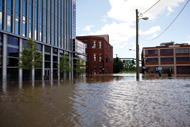|
COVER STORY, JUNE 2010
COMMERCIAL BUOYANCY
Damage to the commercial industry from Nashville’s flood was limited.
Jon Ross
Nashville brokers have been busy surveying the damage to the commercial real estate market left by the swollen Cumberland River and other smaller waterways, which were pushed to their tipping point by a record amount of rainfall May 1. And while the direct affect of the flooding on the commercial market is negligible — the real issue, sources say, is the residential arena — the storm still forced many companies to find temporary square footage in other parts of the city. As Crews Johnston of Cassidy Turley in Nashville says, the biggest threat was the unknown; from a commercial real estate standpoint, the flooding could have certainly caused a lot more damage.
“As the flood was unfolding over the weekend and in to Monday and Tuesday, probably the biggest unknown was whether the levies in Metro Center were going to hold. Had those not held, we would have had 2 or 3 million square feet of office space that would have had to have been relocated for 6 or 12 months,” he says. “That was the real scary part.”
 |
Water is at the door of The Pinnacle at Symphony Place in Nashville. Photo courtesy of Pupon Saiyasak / redpepper.
|
|
The levies held, and most offices located near bodies of water only received a little bit of damage. In the office world, the main impact of the flood was felt by tenants in The Pinnacle at Symphony Place, a new office tower located adjacent to flood victims like the Schermerhorn Symphony Center and the Country Music Hall of Fame. Owned by Atlanta-based Barry Real Estate Cos., the LEED-certified property was really the only major office building that received any damage, Johnston says.
“The reality is that very little institutional commercial real estate was affected. Most people that had garages that were underground were flooded,” Johnston says. “Commercially, in the big continuum of things, we didn’t miss a beat.”
The damage to the residential industry might have more of an affect on the commercial arena — retail, specifically — than the actual flood. Many homeowners were caught without flood insurance, and while these people are rebuilding, they certainly won’t be out shopping or eating at restaurants. Johnston says retail might take a little bit of a hit, but ultimately, any adverse affect will be counterbalanced by the ramp up in home construction. Besides, he points out, there’s already been an influx of private money coming into the city.
“There’s a lot of misery out there,” Johnston says, “but it’s really brought the community together.”
 |
Some flooded industrial properties near Davidson Sreet in Nashville. Photo courtesy of Coral Smith at Aerial Innovations.
|
|
Industrial tenants are out looking for temporary space, says Tom Frye, managing director of CB Richard Ellis’ Nashville office. The space needed runs the gamut, but the biggest user is a tenant looking for 300,000 square feet. Almost all of the older warehouses on Cowan Street in Nashville were impacted by the flood, and many of these users are also searching out new space while cleanup gets under way.
“Some operations have been stalled until temp space can be found,” Frye says. This may be one case where the high industrial vacancy rate in Nashville is actually a good thing. Frye notes that there’s about 4 million square feet of new, vacant space east of the city. “Relocation on a temporary basis is not a problem,” he says. “We can find them buildings.”
While tenants can be relocated, many of the goods housed in the industrial properties has been lost. One of the biggest national stories to come out of the flood is the water damage that occurred at Soundcheck Nashville, a music storage space. Frye estimates that more than half of Nashville’s artists, including many big name acts, stored instruments and stage equipment at the property. In most cases, those items are now unusable. Cleanup of the space started almost immediately.
As for the less high-profile industrial buildings, many of which were built in the 1970s before construction in the 100-year floodplain was forbidden, they just need a good cleaning.
“It’s not like the flood waters are going to wash them away,” Frye says. “They’re just going to make them dirty for a while.”
©2010 France Publications, Inc. Duplication
or reproduction of this article not permitted without authorization
from France Publications, Inc. For information on reprints
of this article contact Barbara
Sherer at (630) 554-6054.
|
